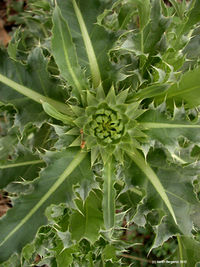Silybum marianum
| See Also | Botanical Monographs |
|---|
The seed of the Milk Thistle (Silybum marianum) plant was considered a specific for stitches in the side. The white veins found on the leaves were thought to represent the Virgin Mary's milk and therefore was used as a galactagogue. The plant has also been used for jaundice and other liver conditions. To explore the characteristics, medicinal uses and prescribing considerations of this herb in more detail, check out the references indicated.[1], [2]
Contents
Characteristics
AKA Carduus marianus, Cnicus marianus
- Common Names: Milk thistle, St. Mary's thistle, Marian thistle, Wild artichoke
- Family: Compositae/Asteraceae
- Habitat: Silybum marianum is native to Mediterranean but is naturalized in California and Australia.
- Parts Used: Seed (contains silymarin), aerial parts
- Constituents: Flavolignan (silymarin)
- Medicinal Actions: hepatoprotective (hepatotonic, antihepatotoxic), cholagogue, bitter, demulcent, galactagogue
Uses
Historical Uses:
The seed of the Silybum marianum plant was considered a specific for stitches in the side. The white veins found on the leaves were thought to represent the Virgin Mary's milk and therefore was used as a galactagogue. The plant has also been used for jaundice and other liver conditions.
Medicinal Uses:
- liver diseases, jaundice, hepatitis, cirrhosis, alcoholism with fatty liver
- Other Conditions
Prescribing Considerations
Because silymarin (the active constituent) is not well extracted in water, German guidelines recommend use of infusion/decoctions only for supportive treatment of functional gallbladder disorders and not for antihepatotoxic effects. Tinctures are impractical because of the high amounts of alcohol needed to obtain adequate dose.
The information provided is intended to augment the treatment from a naturopathic doctor or other trained medical professional. Although most herbs are generally safe, it is recommended that you avoid self-prescribing especially when there is an underlying ongoing medical condition, if you are on any prescription medications or if you are pregnant or breastfeeding.
Formulations and Preparation
- Infusion - 3-4g seed/cup three times daily (for mild digestive disorders)
- Tincture - 2-5mL (60%) three times daily
- Standardized extract - 175-600mg daily (30:1, 80% silymarin); or 600mg daily (70% silymarin)
Safety
The safety and prescribing considerations for this herb include:[3] [4]
- Generally regarded as safe.
- Side-effects are mild gastrointestinal effects and possible allergic reaction.
- Drug-Herb Interactions.[3]
- Cisplatin and Related Platinum-Based Chemotherapy - Beneficial or supportive interaction with professional management, prevention or reduction of drug adverse effect; Silymarin reduced drug-induced nephrotoxicity by countering lipid peroxidation and cell membrane destabilization. Silymarin may additively increase anticancer effects of platinum compounds. Administer during and after chemo-therapy.
- Doxorubicin and Related Anthracycline Chemotherapy - Beneficial or supportive interaction with professional management, prevention or reduction of drug adverse effect; Drug cardiotoxcity is reduced by silymarin. Possible chemosensitization of resistant cells to anthracyclines. Administer as adjunctive to support protocols during and after chemo-therapy.
- Hepatotoxic Substances, Including Acetaminophen, Acetylsalicylic Acid, Antitubercular Agents, Butyrophenone and Phenothiazine Neuroleptics, Ethyl Alcohol, Halothane, Methandienone, Methotrexate, Nortriptyline, and Phenytoin - Prevention or reduction of drug adverse effect, beneficial or supportive interaction not requiring professional management; General drug-induced hepatoxicity is countered by silymarin co-administration.
- Insulin - Potential or theoretical beneficial or supportive interaction with professional management; Silymarin normalizes glycemic control, maintains islet integrity, reduces insulin requirements. Co-adminster long-term.
- Metronidazole and Related Nitroimidazole Antiprotozoals - Impaired drug absorption and bioavailability - Precautions Appropriate, bimodal or variable interaction with professional management, prevention or reduction of drug adverse effect; Co-administration of herb with drug may reduce drug availability by induction of drug-metabolizing enzymes. Avoid Co-administration. Pre-existing herb use may require higher drug dose for therapeutic efficacy.
References
- ↑ Boon Heather, Smith Michael (2009) 55 Most Common Medicinal Herbs: The Complete Natural Medicine Guide Second Edition Institute of Naturopathic Education and Research, CCNM Toronto.
- ↑ Godfrey Anthony, Saunders Paul, Barlow Kerry, Gowan Matt (2011) Principles and Practices of Naturopathic Botanical Medicine, Advanced Botanical Medicine. V3 CCNM Press, Toronto.
- ↑ 3.0 3.1 Stargrove Mitchell Bebell, Treasure Jonathan, McKee Dwight L (2008) Herb, Nutrient and Drug Interactions: Clinical Implications and Therapeutic Strategies.
- ↑ Brinker Francis (1997) Herbal Contraindications and Drug Interactions: Plus Herbal Adjuncts With Medicines, 4th Edition Eclectic Medical Publications.
